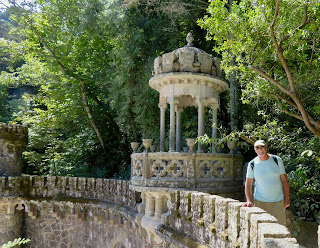Located west of Lisbon, Belém was originally a shipbuilding district and the area where 15th-century explorers launched their vessels. As a popular tourist destination, we headed out early to try to avoid some of the tourist congestion the district is known for. Arriving near the Lisbon waterfront, we hopped on bus 728. We were packed like sardines for our ride to Belém, so much for trying to beat the crowd.
Since we had purchased the Lisbon Card, we bypassed the long line to enter the Mosteiro dos Jeronimos. Construction on this UNESCO heritage site began in 1501 and was completed over 100 years later. Luckily, the Belém area and the ornate Monastery sustained minimal damage in the earthquake of 1755 which destroyed most of Lisbon. Tombs of Portugal’s most famous explorer, Vasco da Gama, and of Luís de Camões, Portugal’s most celebrated poet, lie within the adjoining church.

The popular pastéis de nata, was created at this site by the monks, who sold the pastries to bring in revenue. In 1837 when the monastery closed, the recipe was sold to a local sugar refinery. Their owners soon opened the Pastéis de Belém, and descendants still operate the business. This was our next stop. A line at the bakery is the norm, but it moved quickly and Alan was soon enjoying a couple of freshly baked, warm tarts.

The popular pastéis de nata, was created at this site by the monks, who sold the pastries to bring in revenue. In 1837 when the monastery closed, the recipe was sold to a local sugar refinery. Their owners soon opened the Pastéis de Belém, and descendants still operate the business. This was our next stop. A line at the bakery is the norm, but it moved quickly and Alan was soon enjoying a couple of freshly baked, warm tarts.
Next on our agenda was the Tower of Belém built between 1514 and 1520. It was an important element of the defense at the mouth of the Tagus River with its shape reminiscent of medieval castles. Climbing the 200+ stairs up the narrow, spiral stairway provided a great view of the city and the nearby Discoveries Monument. The monument features Portuguese explorers, led by Henry the Navigator, and includes some royalty and others with links to the early Portuguese navigation.
For our final stop in Belém, we climbed the steep hill to the Ajuda National Palace. Following the earthquake of 1755, King Joseph refused to live in a masonry palace, so the royal family moved to a nearby wooden cabin. Soon after, a wooden palace was built on the site of the current palace, but it was demolished and rebuilt in masonry following the death of the king. Opened in 1795, through the years the palace suffered fire, rain damage, war, and abandonment when the royal family fled to Brazil for thirteen years. Renovations on the palace are ongoing, and it is primarily open as a museum, but the building is also used for state dinners in the elaborate dining room.
 |
| Throne room |
Once again utilizing our Lisbon Card, early the following morning we hopped on a train departing the historic Rossio station in Lisbon for the 40-minute ride to Sintra. The verdant landscape in the area seems to transport visitors to another era. Multiple palaces, country estates, and a medieval castle are found in this town. Portuguese royalty spent time in this area at their palace and it became the "in" place for the rich and famous. With a multitude of options to explore, we decided to visit the Quinta da Regaleira. Completed in 1910, the extensive grounds and unique design elements of the palace were based on the interests of the property owner, António Monteiro. A one-mile plus uphill walk from the center of town, this UNESCO heritage site is one of the most visited in Sintra. Decorated with gargoyles and spires, the surrounding acreage contains towers, tunnels, multiple fountains, two wells (used for ceremonial procedures including Tarot initiation rites, not water) and a waterfall.
Moving back to Lisbon, we prepared for departing the capital and heading south.
Moving back to Lisbon, we prepared for departing the capital and heading south.
 |
| Discoveries Monument |
 |
| Church adjoining the Monastery |
 |
| Alan on the grounds at Quinta da Regaleira |
 |
| Initiation well |
 |
| Moorish castle overlooking Sintra |
 |
| Rossio Square in Lisbon |







No comments:
Post a Comment